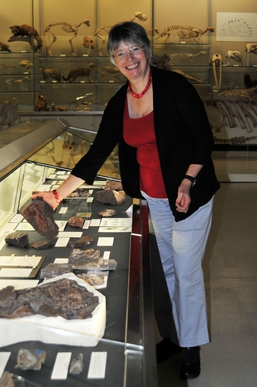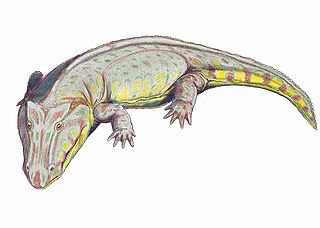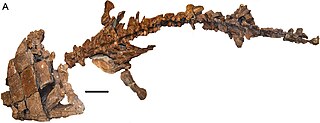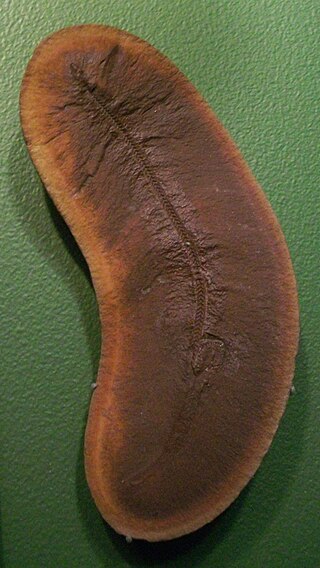
A tetrapod is any four-limbed vertebrate animal of the superclass Tetrapoda. Tetrapods include all extant and extinct amphibians and amniotes, with the latter in turn evolving into two major clades, the sauropsids and synapsids. Some tetrapods such as snakes, legless lizards, and caecilians had evolved to become limbless via mutations of the Hox gene, although some do still have a pair of vestigial spurs that are remnants of the hindlimbs.

Jennifer Alice Clack, was an English palaeontologist and evolutionary biologist. She specialised in the early evolution of tetrapods, specifically studying the "fish to tetrapod" transition: the origin, evolutionary development and radiation of early tetrapods and their relatives among the lobe-finned fishes. She is best known for her book Gaining Ground: the Origin and Early Evolution of Tetrapods, published in 2002 and written with the layperson in mind.

Michael James Benton is a British palaeontologist, and professor of vertebrate palaeontology in the School of Earth Sciences at the University of Bristol. His published work has mostly concentrated on the evolution of Triassic reptiles but he has also worked on extinction events and faunal changes in the fossil record.

Seymouriamorpha were a small but widespread group of limbed vertebrates (tetrapods). They have long been considered reptiliomorphs, and most paleontologists may still accept this point of view, but some analyses suggest that seymouriamorphs are stem-tetrapods. Many seymouriamorphs were terrestrial or semi-aquatic. However, aquatic larvae bearing external gills and grooves from the lateral line system have been found, making them unquestionably amphibians. Though as they matured, they became more terrestrial and reptile-like. They ranged from 30 cm long lizard-sized creatures to the 1.5 m long Enosuchus. If seymouriamorphs are reptiliomorphs, they were the distant relatives of amniotes. Seymouriamorphs form into three main groups, Kotlassiidae, Discosauriscidae, and Seymouriidae, a group that includes the best known genus, Seymouria. The last seymouriamorph became extinct by the end of the Permian.

Peltobatrachus is an extinct genus of temnospondyl amphibian from the late Permian period of Tanzania. The sole species, Peltobatrachus pustulatus, is also the sole member of the family Peltobatrachidae.

Tulerpeton is an extinct genus of Devonian four-limbed vertebrate, known from a fossil that was found in the Tula Region of Russia at a site named Andreyevka. This genus and the closely related Acanthostega and Ichthyostega represent the earliest tetrapods.

Edops is an extinct genus of temnospondyl amphibian from the Early Permian Period. Unlike more advanced temnospondyls of the time, such as Eryops, Edops exhibited an archaic pattern of palatal bones, and still possessed various additional bones at the back of the skull. Edopoids also had particularly big premaxillae and proportionally small external nostrils. Within the clade, the most basal member seems to be Edops from the Early Permian Archer City Formation of the US, a broad-skulled animal with large palatal teeth.

Archegosauridae is a family of relatively large and long snouted temnospondyls that lived in the Permian period. They were fully aquatic animals, and were metabolically and physiologically more similar to fish than modern amphibians. The family has been divided into two subfamilies, the longer-snouted Platyoposaurinae and the shorter-snouted Melosaurinae.

Pelorocephalus is an extinct genus of chigutisaurid temnospondyls. It is known from the Late Triassic (Carnian) Cacheutá Formation of the Cuyo Basin and the Ischigualasto Formation of the Ischigualasto-Villa Unión Basin, both in northwestern Argentina. Four species are currently recognized: the type species P. mendozensis, which was named in 1944, P. tenax, which was named in 1949 as a species of Chigutisaurus and reassigned to Pelorocephalus in 1999, and P. cacheutensis, which was named in 1953 as another species of Chigutisaurus and reassigned to Pelorocephalus along with P. tenax. A fourth species, P. ischigualastensis, was named in 1975 after the formation it was found in. The species P. tunuyanensis was named in 1948 but has since been synonymized with P. mendozensis. The largest individuals are estimated to have reached 107 centimetres (42 in) in length.

Siderops is an extinct genus of chigutisaurid temnospondyl from Early Jurassic of Australia, containing the species S. kehli.

Lydekkerinidae is a family of stereospondyl temnospondyls that lived in the Early Triassic period. During this time period, lydekkerinids were widely distributed, with putative remains reported from Russia, Greenland, India, South Africa, Madagascar, Australia, and Antarctica. In contrast to most other stereospondyls, lydekkerinids were relatively small-bodied. The type genus is Lydekkerina, the namesake of the family and the best-known lydekkerinid.

Lapillopsis is an extinct genus of stereospondyl temnospondyl within the family Lapillopsidae. Fossils belonging to the genus have been found in the Arcadia Formation of Queensland, Australia.

Pseudophlegethontia is an extinct genus of aïstopod stegocephalians. It is the only member of the family Pseudophlegethontiidae. The only species is the type species P. turnbullorum, named in 2003. Fossils of Pseudophlegethontia have been found from the Mazon Creek fossil beds in Grundy County, Illinois, a conservation lagerstätte well known for the exceptional preservation of middle Pennsylvanian taxa.
Pariotichus is an extinct genus of gymnarthrid microsaurs from the early Permian of Texas.
Stegotretus is an extinct genus of lepospondyl microsaur referred to the Pantylidae. It is known from the Carboniferous–Permian boundary Cutler Formation exposures of New Mexico.

Caerorhachis is an extinct genus of early tetrapod from the Early Carboniferous of Scotland, probably from the Serpukhovian stage. Its placement within Tetrapoda is uncertain, but it is generally regarded as a primitive member of the group. The type species C. bairdi was named in 1977.

Melosaurinae is an extinct subfamily of temnospondyl amphibians, part of the family Archegosauridae. Most melosaurines are known from Russia, although an unnamed species has been found in Brazil. Unlike the long-skulled archegosaurids of the family Platyoposaurinae, melosaurines have shorter, broadened snouts.
Koinia is an extinct genus of temnospondyl amphibian from the Late Permian of Russia. It is an archegosauroid in the subfamily Melosaurinae. Koinia was named in 1993 with the description of the type species K. silantjevi, based on fossils that were found in the Ocher Assemblage Zone, near the Vym River in the Komi Republic.
Uralosuchus is an extinct genus of temnospondyl amphibian from the Late Permian of Russia, belonging to the group Archegosauroidea. It is a member of the archegosauroidean subfamily Melosaurinae. Fossils have been found in Orenburg Oblast. Uralosuchus was named in 1993 with the description of the type species U. tverdochlebovae.
Kashmirosaurus is an extinct genus of temnospondyl amphibian known from Permo-Carboniferous deposits in the region of Kashmir. It was originally named by English paleontologist Arthur Smith Woodward in 1905 as a species of Archegosaurus called Archegosaurus ornatus. More recently, the species has been recognized as being distinct from Archegosaurus, and it was placed in its own genus Kashmirosaurus in 1996. An additional species of Archegosaurus, A. kashmiriensis, was named in 1960 from the same deposits in Kashmir, and is now considered synonymous with Kashmirosaurus ornatus.














